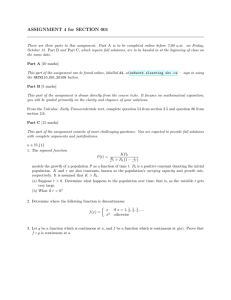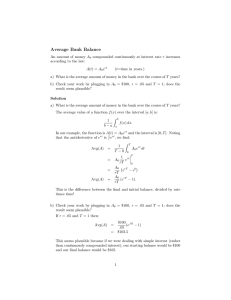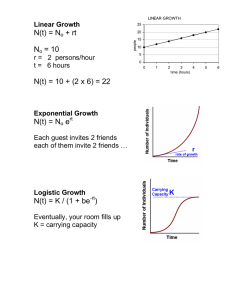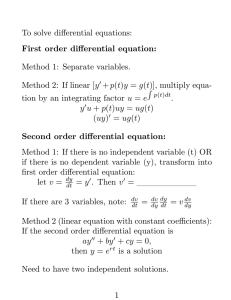Solutions - UC Davis Mathematics
advertisement
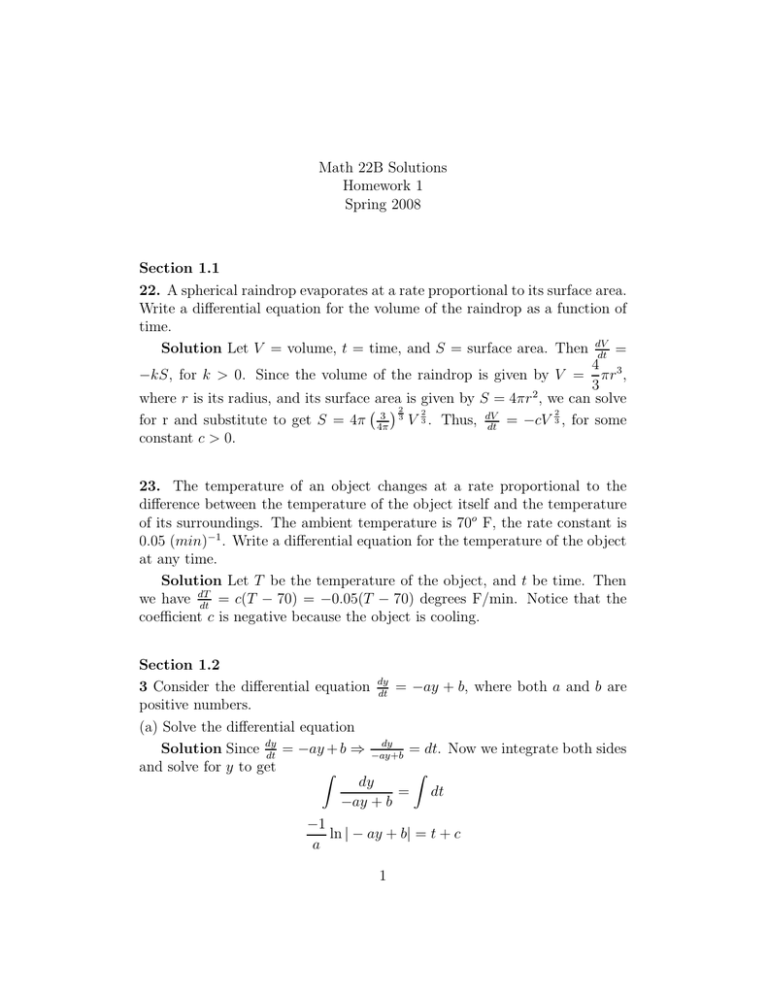
Math 22B Solutions Homework 1 Spring 2008 Section 1.1 22. A spherical raindrop evaporates at a rate proportional to its surface area. Write a differential equation for the volume of the raindrop as a function of time. Solution Let V = volume, t = time, and S = surface area. Then dV = dt 4 3 −kS, for k > 0. Since the volume of the raindrop is given by V = πr , 3 where r is its radius, and its surface area is given by S = 4πr 2 , we can solve 2 2 2 3 3 for r and substitute to get S = 4π 4π V 3 . Thus, dV = −cV 3 , for some dt constant c > 0. 23. The temperature of an object changes at a rate proportional to the difference between the temperature of the object itself and the temperature of its surroundings. The ambient temperature is 70o F, the rate constant is 0.05 (min)−1 . Write a differential equation for the temperature of the object at any time. Solution Let T be the temperature of the object, and t be time. Then = c(T − 70) = −0.05(T − 70) degrees F/min. Notice that the we have dT dt coefficient c is negative because the object is cooling. Section 1.2 3 Consider the differential equation dy = −ay + b, where both a and b are dt positive numbers. (a) Solve the differential equation dy Solution Since dy = −ay + b ⇒ −ay+b = dt. Now we integrate both sides dt and solve for y to get Z Z dy = dt −ay + b −1 ln | − ay + b| = t + c a 1 ln | − ay + b| −1 a = et+c = c′ et −ay + b = c′ e−at ⇒ y(t) = b − ce−at a (b) see figure 1 (c) (i) As a increases the equilibrium solution gets smaller. The convergence rate increases as well. (ii) As b increases, the equilibrium solution gets larger. The convergence rate stays the same. (iii) As a and b both increase, the equilibrium solution stays the same, but the convergence rate increases for all solutions. 8. (a) Find the rate constant r if the population doubles in 30 days. Solution The general solution is p(t) = p0 ert where time is measured in months, so 30 days is 1 month for t = 1. We plug in constants to get 2p0 = p0 er ∗ 1. If we solve for r, we get r = ln(2) per month. (b) Find r if the population doubles in N days. N Solution Again, time is in months, so t = 30 months. We solve for r as N 30 r 30 in part (a) to get 2p0 = p0 e ⇔ r = ln(2) N per month. 17. Q (a) R dQ +Q = V . In order to separate variables we need R dQ = V −C ⇔ dt C dt dQ dt = R . Integrating both sides we get V −Q C Z dQ = V −Q C Z dt R Q t = +C C R t Q +c ln V − = C −cR −t Q V − = ce cR C −c ln V − 2 −t Q = CV − Cce cR −t Q(0) = 0 = CV − Cce cR −t Q(t) = CV (1 − e cR See figure 2 for more reference. Section 1.3 Determine the order and state whether it is linear or nonlinear. 2 1. t2 ddt2y + t dy + 2y = sint dt Solution Since the highest derivative is second order, the equation is second order. Moreover, the equation is linear since it has the form an (t)y (n) + ... + a0 (t)y = g(t) d4 y dt4 3 (1) 2 + ddt3y + ddt2y + dy +y =1 dt Solution The highest derivative is fourth order, so the equation is fourth order. This equation also has the form (1), so it is also linear. 3. dy dt + ty 2 = 0 Solution There is only one derivative, and it is of order 1, so the equation is first order. The equation is non-linear because it has the term y 2. 4. d2 y dt2 + sin(t + y) = sint Solution The equation is second order because the highest order derivative is of order two. Since sin(t + y) is a term, the equation is not linear. 5. Verify that each is a solution of the differential equation 9. ty ′ − y = t2 , y = 3t + t2 Solution We differentiate y to obtain y ′ = 3 + 2t. Substituting in to the differential equation gives ty ′ − y = t(3t + 2t) − (3t + t2 ) = 3t + 2t2 − 3t − t2 = t2 , as desired. Determine the values of r for which the given differential equation has solutions of the form y = ert . 3 15. y ′ + 2y = 0 Solution We substitute y = ert and y ′ = rert into the equation to get rert + 2ert = 0. This implies that rert = −2ert , which gives us that r = −2. 16. y ′′ − y = 0 Solution We substitute y = ert , y ′ = rert , and y ′′ = r 2 ert into the equation to get r 2 ert − ert = 0. Then we have (r 2 − 1)ert = 0, which implies that r 2 − 1 = 0 since ert is never zero. Thus, r = ±1. 29. See textbook page 25 for question. Solution (a) see figure (3) (b) We have that F = ma, but for the tangential direction. Let Fθ = mat heta. The only force acting in the tangential direction is the weight, so Fθ = −mgsinθ. The acceleration at heta is the linear acceleration along the 2 2 path at heta = L ddt2θ , as given in the problem. So −mgsinθ = mL ddt2θ . See figure 4 for more reference. 2 2 (c) From part (b), we have −mgsinθ = mL ddt2θ , so L ddt2θ + gsinθ = 0, 2 which implies that ddt2θ + Lg sinθ = 0. 30. See book pgs. 25-26 for problem. (a) The kinetic energy of mass m is given by T = 21 mv 2 , where v is the velocity. A particle in motion on a circle of radius L has speed L dθ , where θ dt dθ 1 dθ 2 is angular position, dt is angular speed. So T = 2 m(L dt ) . (b) Potential energy is given by mgh, where h is the height and g is the gravity. If we take v = 0, the lowest point of the swing is h = L. If the pendulum is not at the lowest point of the swing, h = L(1 − cosθ). So V = mgL(1 − cosθ) See figure 5 for more reference. (c) E = T + V ⇒ E = 12 mL2 ( dθ )2 + mgL(1 − cosθ). So then dt dθ d2 θ dθ dE = mL2 + mgLsinθ 2 dt dt dt dt by the Chain Rule. Then we set dT dt = 0 to get dθ d2 θ + mglsinθ 0 = mL 2 dt dt dt 2 dθ 4 Dividing both sides by mL dθ we get dt d2 θ 1 d2 θ 0 = L 2 + gsinθ, or 0 = 2 + gsinθ dt dt L 5
